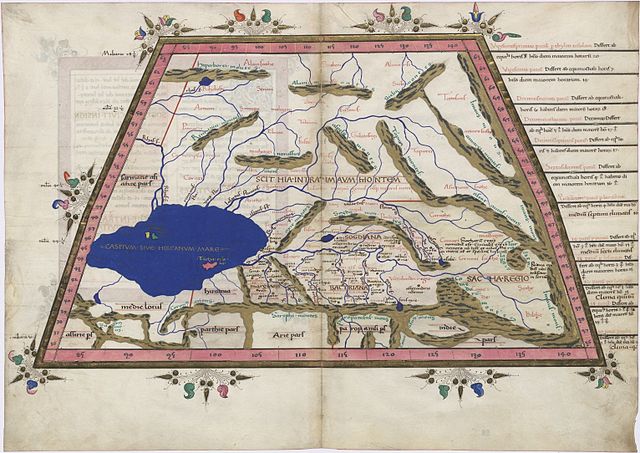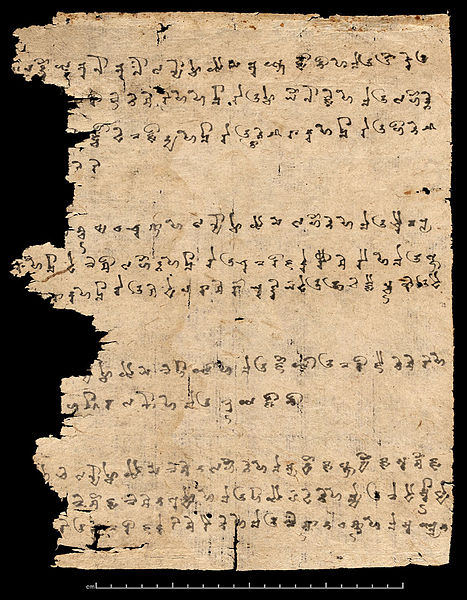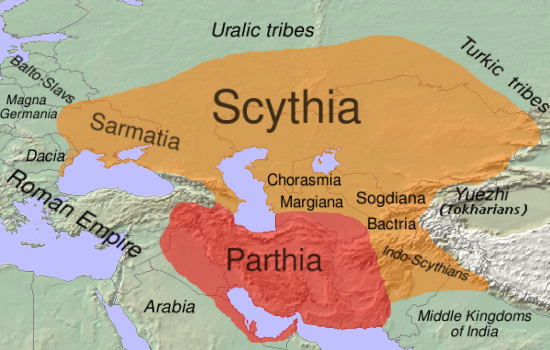
| SCYTHIAN LANGUAGES
Ptolemy's Scythia Scythian
Native to : Sarmatia, Scythia, Sistan, Scythia Minor, Alania
Region : Central Asia, Eastern Europe
Ethnicity : Scythians, Sarmatians, and Alans
Era : Classical antiquity, late antiquity
Language family :
Indo-European
Dialects
Language codes
ISO 639-3
Variously :
xsc - Scythian
xln - Alanian
oos - Old Ossetian
Linguist List :
xsc Scythian
xln Alanian
oos Old Ossetian
Glottolog :
oldo1234 Old Ossetic
The Scythian languages are a group of Eastern Iranian languages of the classical and late antique period (the Middle Iranian period), spoken in a vast region of Eurasia named Scythia. Except for modern Ossetian, which descends from the Alanian variety, these languages are all considered to be extinct. Modern Eastern Iranian languages such as Wakhi, however, are related to the eastern Scytho-Khotanese dialects attested from the kingdoms of Khotan and Tumshuq in the ancient Tarim Basin, in present-day southern Xinjiang, China.
The location and extent of Scythia varied by time, but generally it encompassed the part of Eastern Europe east of the Vistula river and much of Central Asia up to the Tarim Basin. Its speakers were part of the wider Scythian cultures, which included Massagetae, Saka, Sarmatians, Scythians and others. The dominant ethnic groups among the Scythian-speakers were nomadic pastoralists of Central Asia and the Pontic-Caspian steppe. Fragments of their speech known from inscriptions and words quoted in ancient authors as well as analysis of their names indicate that it was an Indo-European language, more specifically from the Iranian group of Indo-Iranian languages. Alexander Lubotsky summarizes the known linguistic landscape as follows :
Unfortunately, we know next to nothing about the Scythian of that period [Old Iranian] – we have only a couple of personal and tribal names in Greek and Persian sources at our disposal – and cannot even determine with any degree of certainty whether it was a single language.
Classification
:
Some scholars detect a division of Scythian into two dialects: a western, more conservative dialect, and an eastern, more innovative one. The Scythian languages may have formed a dialect continuum :
•
Alanian languages or Scytho-Sarmatian in the west: were spoken by
people originally of Iranian stock from the 8th and 7th century
BC onwards in the area of Ukraine, Southern Russia and Kazakhstan.
Modern Ossetian survives as a continuation of the language family
possibly represented by Scytho-Sarmatian inscriptions, although
the Scytho-Sarmatian language family "does not simply represent
the same [Ossetian] language" at an earlier date.
A document from Khotan written in Khotanese Saka, part of the Eastern Iranian branch of the Indo-European languages, listing the animals of the Chinese zodiac in the cycle of predictions for people born in that year; ink on paper, early 9th century
History :
The approximate distribution of Eastern Iranian languages in 100 BC appears in orange [citation needed] Early Eastern Iranians originated in the Yaz culture (ca. 1500–1100 BC) in Central Asia. [citation needed] The Scythians migrated from Central Asia toward Eastern Europe in the 8th and 7th century BC, occupying today's Southern Russia and Ukraine and the Carpathian Basin and parts of Moldova and Dobruja. They disappeared from history after the Hunnish invasion of Europe in the 5th century AD, and Turkic (Avar, Batsange, etc.) and Slavic peoples probably assimilated most people speaking Scythian. [citation needed] However, in the Caucasus, the Ossetian language belonging to the Scythian linguistic continuum remains in use today, while in Central Asia, some languages belonging to Eastern Iranian group are still spoken, namely Pashto, Pamir languages and Yaghnobi.
Corpus
:
An inscription from Saqqez written in the Hieroglyphic Hittite script may represent Scythian :
Transliteration
: par-tì-ta5-wa5 ki-s3-a4-á KUR-u-pa-ti QU-wa-a5 |
i5-pa-s2-a-m2
The Issyk inscription, found in a Scythian kurgan dating approximately to the 4th century BC, remains undeciphered, but some authorities assume that it represents Scythian.
Personal
names :
Some scholars believe that many toponyms and hydronyms of the Russian and Ukrainian steppe have Scythian links. For example, Vasmer associates the name of the river Don with an assumed/reconstructed unattested Scythian word *danu "water, river", and with Avestan danu-, Pashto dand and Ossetian don. The river names Don, Donets, Dnieper, Danube, and Dniester, and lake Donuzlav (the deepest one in Crimea) may also belong with the same word-group.
Herodotus'
Scythian etymologies :
•
Most scholars associate oior "man" with Avestan vira-
"man, hero", Sanskrit vira-, Latin vir (gen. viri) "man,
hero, husband", PIE *wiHrós. Various explanations account
for pata "kill" :
•
Some scholars connect arima "one" with Ossetian ærmæst
"only", Avestic airime "quiet", Greek eremos
"empty", PIE *h1(e)rh1mo-?, and spu "eye" with
Avestic spas- "foretell", Sanskrit spas-, PIE *spek- "see".
•
Tabiti = Hestia. Perhaps related to Sanskrit Tapati, a heroine in
the Mahabharata, literally "the burning (one)".
Aristophanes
:
Alanian
:
Source :
https://en.wikipedia.org/ |


